University of South Australia: Aviation Management Cooperation Report
VerifiedAdded on 2021/06/17
|6
|1346
|166
Report
AI Summary
This report, titled "Global Airline Cooperation: Equity Stakes, Strategic Partnerships and Alliance Membership," examines the core strategies employed by major airlines for global expansion. Conducted using a five-stage Delphi study, the research analyzes strategic partnerships, alliance memberships, and equity stakes as key components of global cooperation within the airline industry. The study identifies current and future trends, highlighting the importance of these cooperation strategies for airlines seeking to broaden their global reach. It also contrasts historical practices with contemporary realities, emphasizing the need for flexible strategies and recognizing regional differences and associated risks. The report concludes that global airline cooperation, including strategic partnerships, alliance memberships, and equity stakes, is expected to persist. Furthermore, it underscores the need for continued research to uncover insights into emerging markets and foster expertise development within the aviation sector. The report also reviews the PESTLE framework and Porter's Five Forces to analyze the industry's dynamics and potential opportunities.
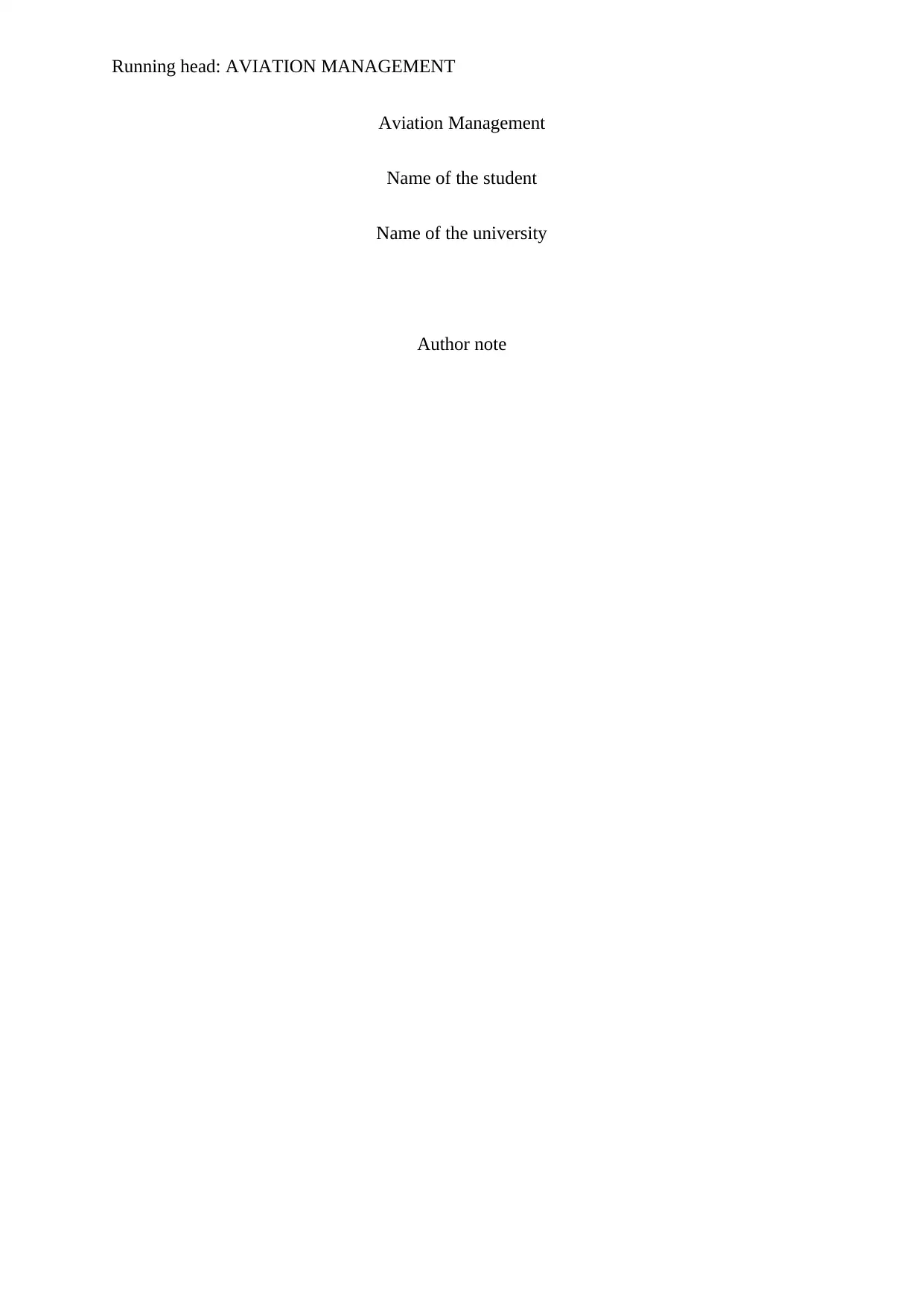
Running head: AVIATION MANAGEMENT
Aviation Management
Name of the student
Name of the university
Author note
Aviation Management
Name of the student
Name of the university
Author note
Paraphrase This Document
Need a fresh take? Get an instant paraphrase of this document with our AI Paraphraser
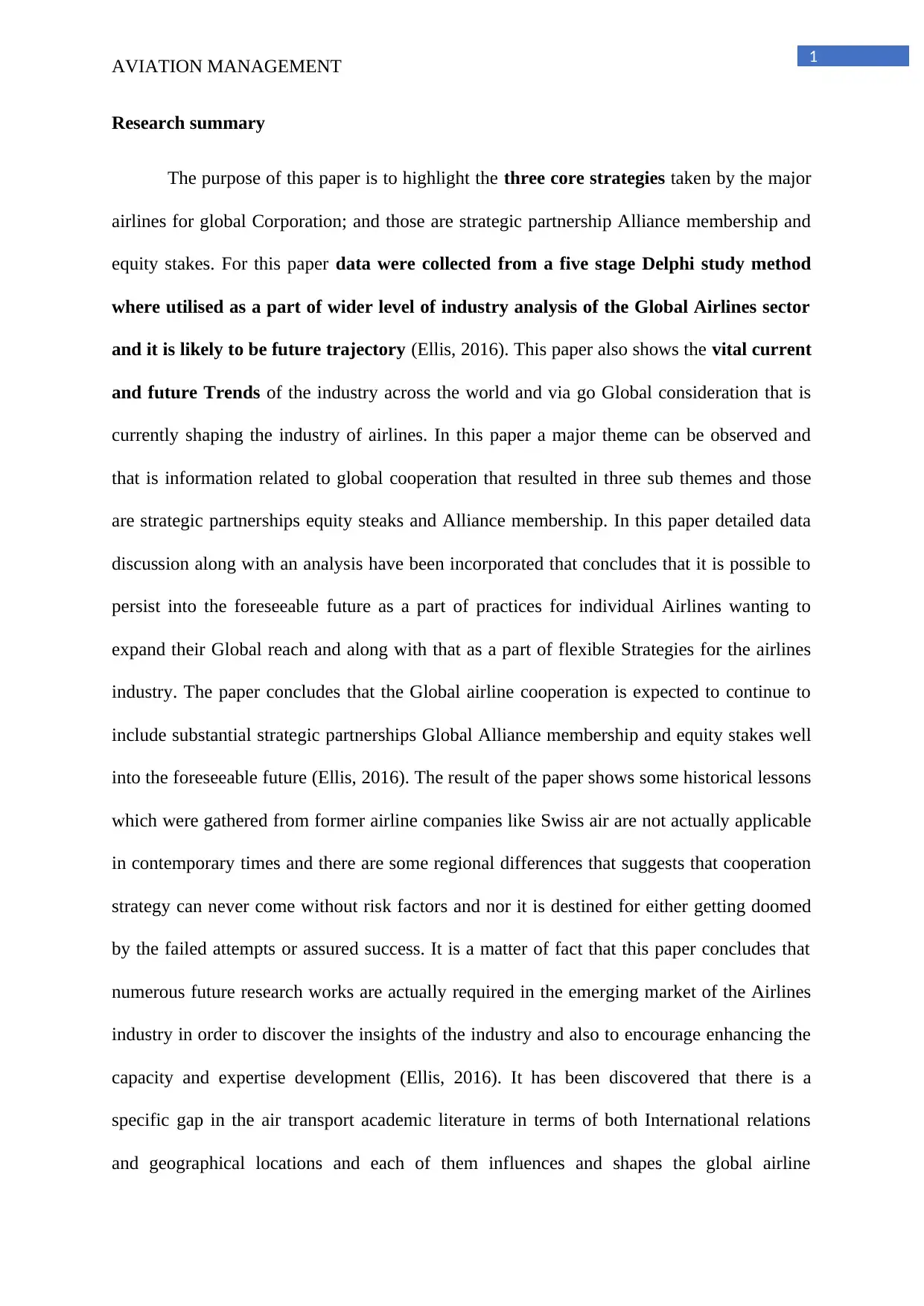
1
AVIATION MANAGEMENT
Research summary
The purpose of this paper is to highlight the three core strategies taken by the major
airlines for global Corporation; and those are strategic partnership Alliance membership and
equity stakes. For this paper data were collected from a five stage Delphi study method
where utilised as a part of wider level of industry analysis of the Global Airlines sector
and it is likely to be future trajectory (Ellis, 2016). This paper also shows the vital current
and future Trends of the industry across the world and via go Global consideration that is
currently shaping the industry of airlines. In this paper a major theme can be observed and
that is information related to global cooperation that resulted in three sub themes and those
are strategic partnerships equity steaks and Alliance membership. In this paper detailed data
discussion along with an analysis have been incorporated that concludes that it is possible to
persist into the foreseeable future as a part of practices for individual Airlines wanting to
expand their Global reach and along with that as a part of flexible Strategies for the airlines
industry. The paper concludes that the Global airline cooperation is expected to continue to
include substantial strategic partnerships Global Alliance membership and equity stakes well
into the foreseeable future (Ellis, 2016). The result of the paper shows some historical lessons
which were gathered from former airline companies like Swiss air are not actually applicable
in contemporary times and there are some regional differences that suggests that cooperation
strategy can never come without risk factors and nor it is destined for either getting doomed
by the failed attempts or assured success. It is a matter of fact that this paper concludes that
numerous future research works are actually required in the emerging market of the Airlines
industry in order to discover the insights of the industry and also to encourage enhancing the
capacity and expertise development (Ellis, 2016). It has been discovered that there is a
specific gap in the air transport academic literature in terms of both International relations
and geographical locations and each of them influences and shapes the global airline
AVIATION MANAGEMENT
Research summary
The purpose of this paper is to highlight the three core strategies taken by the major
airlines for global Corporation; and those are strategic partnership Alliance membership and
equity stakes. For this paper data were collected from a five stage Delphi study method
where utilised as a part of wider level of industry analysis of the Global Airlines sector
and it is likely to be future trajectory (Ellis, 2016). This paper also shows the vital current
and future Trends of the industry across the world and via go Global consideration that is
currently shaping the industry of airlines. In this paper a major theme can be observed and
that is information related to global cooperation that resulted in three sub themes and those
are strategic partnerships equity steaks and Alliance membership. In this paper detailed data
discussion along with an analysis have been incorporated that concludes that it is possible to
persist into the foreseeable future as a part of practices for individual Airlines wanting to
expand their Global reach and along with that as a part of flexible Strategies for the airlines
industry. The paper concludes that the Global airline cooperation is expected to continue to
include substantial strategic partnerships Global Alliance membership and equity stakes well
into the foreseeable future (Ellis, 2016). The result of the paper shows some historical lessons
which were gathered from former airline companies like Swiss air are not actually applicable
in contemporary times and there are some regional differences that suggests that cooperation
strategy can never come without risk factors and nor it is destined for either getting doomed
by the failed attempts or assured success. It is a matter of fact that this paper concludes that
numerous future research works are actually required in the emerging market of the Airlines
industry in order to discover the insights of the industry and also to encourage enhancing the
capacity and expertise development (Ellis, 2016). It has been discovered that there is a
specific gap in the air transport academic literature in terms of both International relations
and geographical locations and each of them influences and shapes the global airline
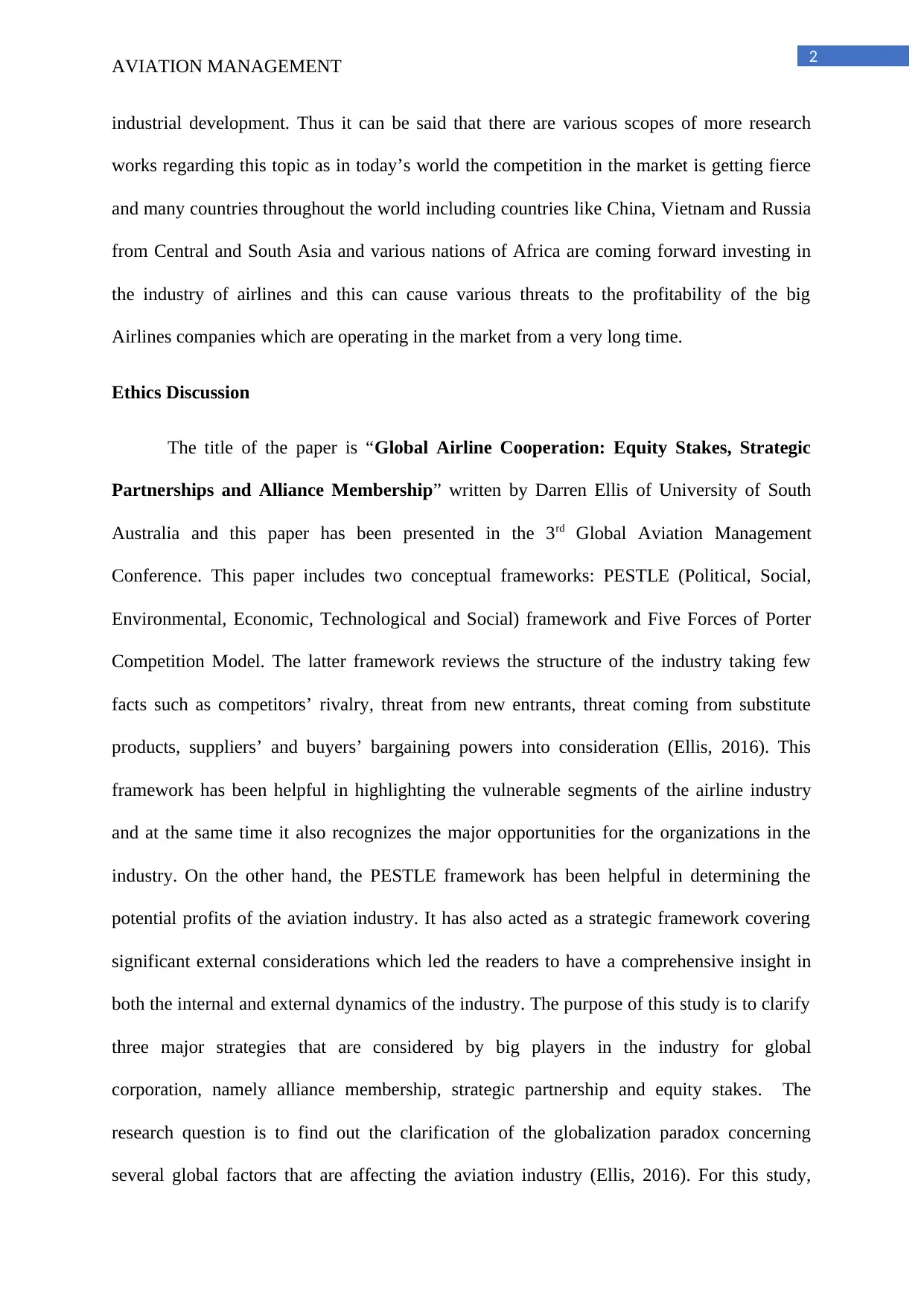
2
AVIATION MANAGEMENT
industrial development. Thus it can be said that there are various scopes of more research
works regarding this topic as in today’s world the competition in the market is getting fierce
and many countries throughout the world including countries like China, Vietnam and Russia
from Central and South Asia and various nations of Africa are coming forward investing in
the industry of airlines and this can cause various threats to the profitability of the big
Airlines companies which are operating in the market from a very long time.
Ethics Discussion
The title of the paper is “Global Airline Cooperation: Equity Stakes, Strategic
Partnerships and Alliance Membership” written by Darren Ellis of University of South
Australia and this paper has been presented in the 3rd Global Aviation Management
Conference. This paper includes two conceptual frameworks: PESTLE (Political, Social,
Environmental, Economic, Technological and Social) framework and Five Forces of Porter
Competition Model. The latter framework reviews the structure of the industry taking few
facts such as competitors’ rivalry, threat from new entrants, threat coming from substitute
products, suppliers’ and buyers’ bargaining powers into consideration (Ellis, 2016). This
framework has been helpful in highlighting the vulnerable segments of the airline industry
and at the same time it also recognizes the major opportunities for the organizations in the
industry. On the other hand, the PESTLE framework has been helpful in determining the
potential profits of the aviation industry. It has also acted as a strategic framework covering
significant external considerations which led the readers to have a comprehensive insight in
both the internal and external dynamics of the industry. The purpose of this study is to clarify
three major strategies that are considered by big players in the industry for global
corporation, namely alliance membership, strategic partnership and equity stakes. The
research question is to find out the clarification of the globalization paradox concerning
several global factors that are affecting the aviation industry (Ellis, 2016). For this study,
AVIATION MANAGEMENT
industrial development. Thus it can be said that there are various scopes of more research
works regarding this topic as in today’s world the competition in the market is getting fierce
and many countries throughout the world including countries like China, Vietnam and Russia
from Central and South Asia and various nations of Africa are coming forward investing in
the industry of airlines and this can cause various threats to the profitability of the big
Airlines companies which are operating in the market from a very long time.
Ethics Discussion
The title of the paper is “Global Airline Cooperation: Equity Stakes, Strategic
Partnerships and Alliance Membership” written by Darren Ellis of University of South
Australia and this paper has been presented in the 3rd Global Aviation Management
Conference. This paper includes two conceptual frameworks: PESTLE (Political, Social,
Environmental, Economic, Technological and Social) framework and Five Forces of Porter
Competition Model. The latter framework reviews the structure of the industry taking few
facts such as competitors’ rivalry, threat from new entrants, threat coming from substitute
products, suppliers’ and buyers’ bargaining powers into consideration (Ellis, 2016). This
framework has been helpful in highlighting the vulnerable segments of the airline industry
and at the same time it also recognizes the major opportunities for the organizations in the
industry. On the other hand, the PESTLE framework has been helpful in determining the
potential profits of the aviation industry. It has also acted as a strategic framework covering
significant external considerations which led the readers to have a comprehensive insight in
both the internal and external dynamics of the industry. The purpose of this study is to clarify
three major strategies that are considered by big players in the industry for global
corporation, namely alliance membership, strategic partnership and equity stakes. The
research question is to find out the clarification of the globalization paradox concerning
several global factors that are affecting the aviation industry (Ellis, 2016). For this study,
⊘ This is a preview!⊘
Do you want full access?
Subscribe today to unlock all pages.

Trusted by 1+ million students worldwide
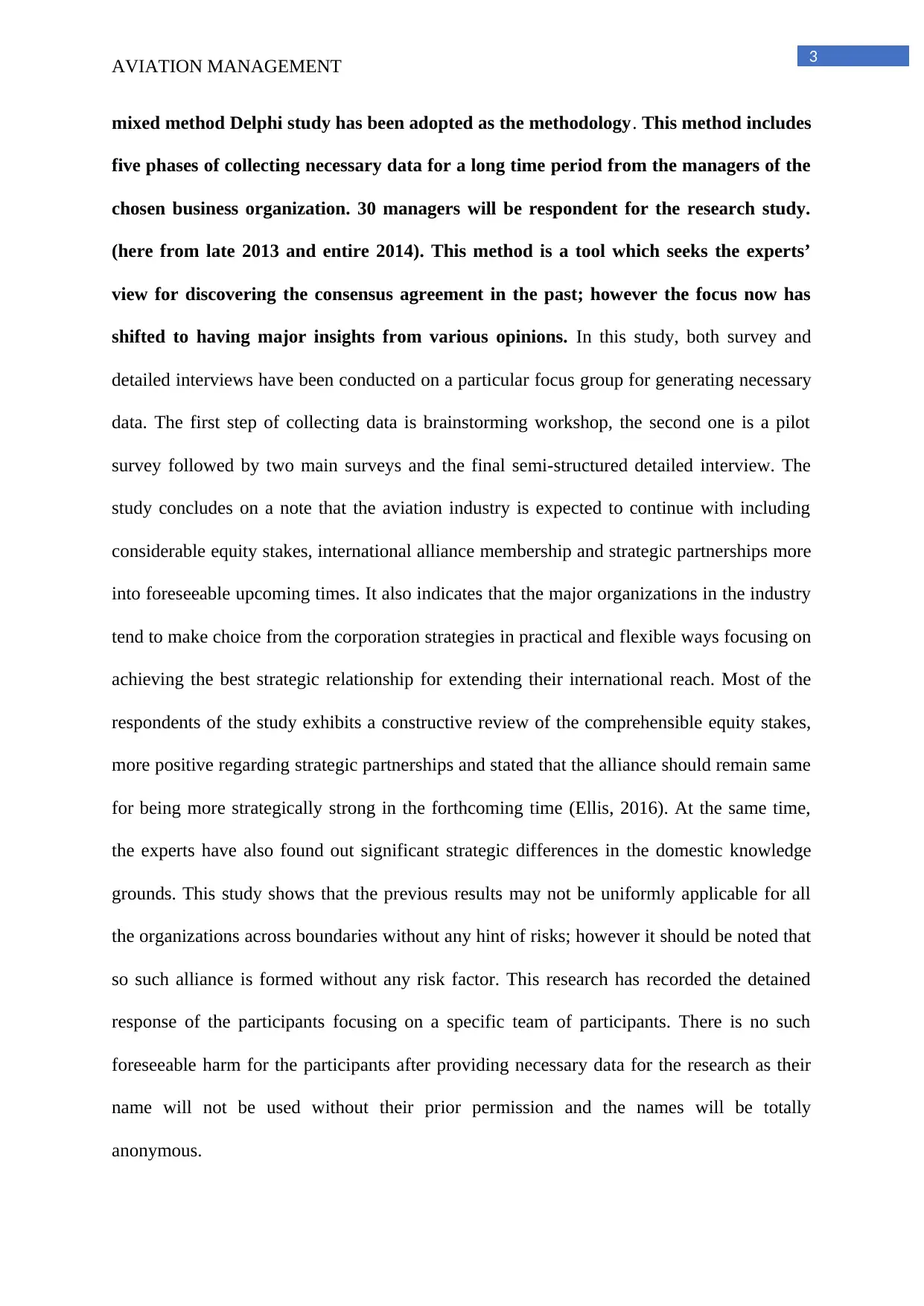
3
AVIATION MANAGEMENT
mixed method Delphi study has been adopted as the methodology. This method includes
five phases of collecting necessary data for a long time period from the managers of the
chosen business organization. 30 managers will be respondent for the research study.
(here from late 2013 and entire 2014). This method is a tool which seeks the experts’
view for discovering the consensus agreement in the past; however the focus now has
shifted to having major insights from various opinions. In this study, both survey and
detailed interviews have been conducted on a particular focus group for generating necessary
data. The first step of collecting data is brainstorming workshop, the second one is a pilot
survey followed by two main surveys and the final semi-structured detailed interview. The
study concludes on a note that the aviation industry is expected to continue with including
considerable equity stakes, international alliance membership and strategic partnerships more
into foreseeable upcoming times. It also indicates that the major organizations in the industry
tend to make choice from the corporation strategies in practical and flexible ways focusing on
achieving the best strategic relationship for extending their international reach. Most of the
respondents of the study exhibits a constructive review of the comprehensible equity stakes,
more positive regarding strategic partnerships and stated that the alliance should remain same
for being more strategically strong in the forthcoming time (Ellis, 2016). At the same time,
the experts have also found out significant strategic differences in the domestic knowledge
grounds. This study shows that the previous results may not be uniformly applicable for all
the organizations across boundaries without any hint of risks; however it should be noted that
so such alliance is formed without any risk factor. This research has recorded the detained
response of the participants focusing on a specific team of participants. There is no such
foreseeable harm for the participants after providing necessary data for the research as their
name will not be used without their prior permission and the names will be totally
anonymous.
AVIATION MANAGEMENT
mixed method Delphi study has been adopted as the methodology. This method includes
five phases of collecting necessary data for a long time period from the managers of the
chosen business organization. 30 managers will be respondent for the research study.
(here from late 2013 and entire 2014). This method is a tool which seeks the experts’
view for discovering the consensus agreement in the past; however the focus now has
shifted to having major insights from various opinions. In this study, both survey and
detailed interviews have been conducted on a particular focus group for generating necessary
data. The first step of collecting data is brainstorming workshop, the second one is a pilot
survey followed by two main surveys and the final semi-structured detailed interview. The
study concludes on a note that the aviation industry is expected to continue with including
considerable equity stakes, international alliance membership and strategic partnerships more
into foreseeable upcoming times. It also indicates that the major organizations in the industry
tend to make choice from the corporation strategies in practical and flexible ways focusing on
achieving the best strategic relationship for extending their international reach. Most of the
respondents of the study exhibits a constructive review of the comprehensible equity stakes,
more positive regarding strategic partnerships and stated that the alliance should remain same
for being more strategically strong in the forthcoming time (Ellis, 2016). At the same time,
the experts have also found out significant strategic differences in the domestic knowledge
grounds. This study shows that the previous results may not be uniformly applicable for all
the organizations across boundaries without any hint of risks; however it should be noted that
so such alliance is formed without any risk factor. This research has recorded the detained
response of the participants focusing on a specific team of participants. There is no such
foreseeable harm for the participants after providing necessary data for the research as their
name will not be used without their prior permission and the names will be totally
anonymous.
Paraphrase This Document
Need a fresh take? Get an instant paraphrase of this document with our AI Paraphraser

4
AVIATION MANAGEMENT
AVIATION MANAGEMENT
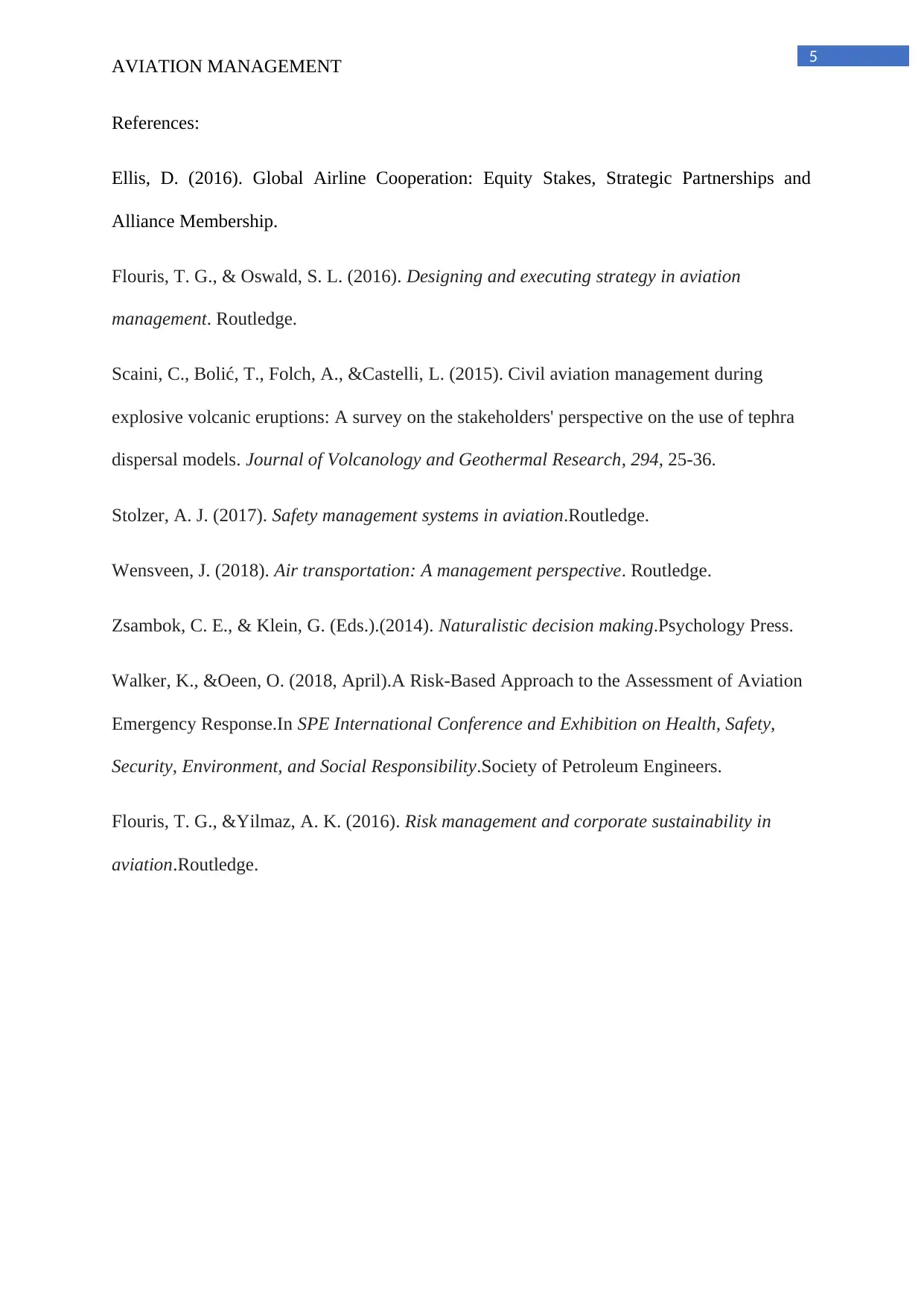
5
AVIATION MANAGEMENT
References:
Ellis, D. (2016). Global Airline Cooperation: Equity Stakes, Strategic Partnerships and
Alliance Membership.
Flouris, T. G., & Oswald, S. L. (2016). Designing and executing strategy in aviation
management. Routledge.
Scaini, C., Bolić, T., Folch, A., &Castelli, L. (2015). Civil aviation management during
explosive volcanic eruptions: A survey on the stakeholders' perspective on the use of tephra
dispersal models. Journal of Volcanology and Geothermal Research, 294, 25-36.
Stolzer, A. J. (2017). Safety management systems in aviation.Routledge.
Wensveen, J. (2018). Air transportation: A management perspective. Routledge.
Zsambok, C. E., & Klein, G. (Eds.).(2014). Naturalistic decision making.Psychology Press.
Walker, K., &Oeen, O. (2018, April).A Risk-Based Approach to the Assessment of Aviation
Emergency Response.In SPE International Conference and Exhibition on Health, Safety,
Security, Environment, and Social Responsibility.Society of Petroleum Engineers.
Flouris, T. G., &Yilmaz, A. K. (2016). Risk management and corporate sustainability in
aviation.Routledge.
AVIATION MANAGEMENT
References:
Ellis, D. (2016). Global Airline Cooperation: Equity Stakes, Strategic Partnerships and
Alliance Membership.
Flouris, T. G., & Oswald, S. L. (2016). Designing and executing strategy in aviation
management. Routledge.
Scaini, C., Bolić, T., Folch, A., &Castelli, L. (2015). Civil aviation management during
explosive volcanic eruptions: A survey on the stakeholders' perspective on the use of tephra
dispersal models. Journal of Volcanology and Geothermal Research, 294, 25-36.
Stolzer, A. J. (2017). Safety management systems in aviation.Routledge.
Wensveen, J. (2018). Air transportation: A management perspective. Routledge.
Zsambok, C. E., & Klein, G. (Eds.).(2014). Naturalistic decision making.Psychology Press.
Walker, K., &Oeen, O. (2018, April).A Risk-Based Approach to the Assessment of Aviation
Emergency Response.In SPE International Conference and Exhibition on Health, Safety,
Security, Environment, and Social Responsibility.Society of Petroleum Engineers.
Flouris, T. G., &Yilmaz, A. K. (2016). Risk management and corporate sustainability in
aviation.Routledge.
⊘ This is a preview!⊘
Do you want full access?
Subscribe today to unlock all pages.

Trusted by 1+ million students worldwide
1 out of 6
Your All-in-One AI-Powered Toolkit for Academic Success.
+13062052269
info@desklib.com
Available 24*7 on WhatsApp / Email
![[object Object]](/_next/static/media/star-bottom.7253800d.svg)
Unlock your academic potential
Copyright © 2020–2025 A2Z Services. All Rights Reserved. Developed and managed by ZUCOL.
